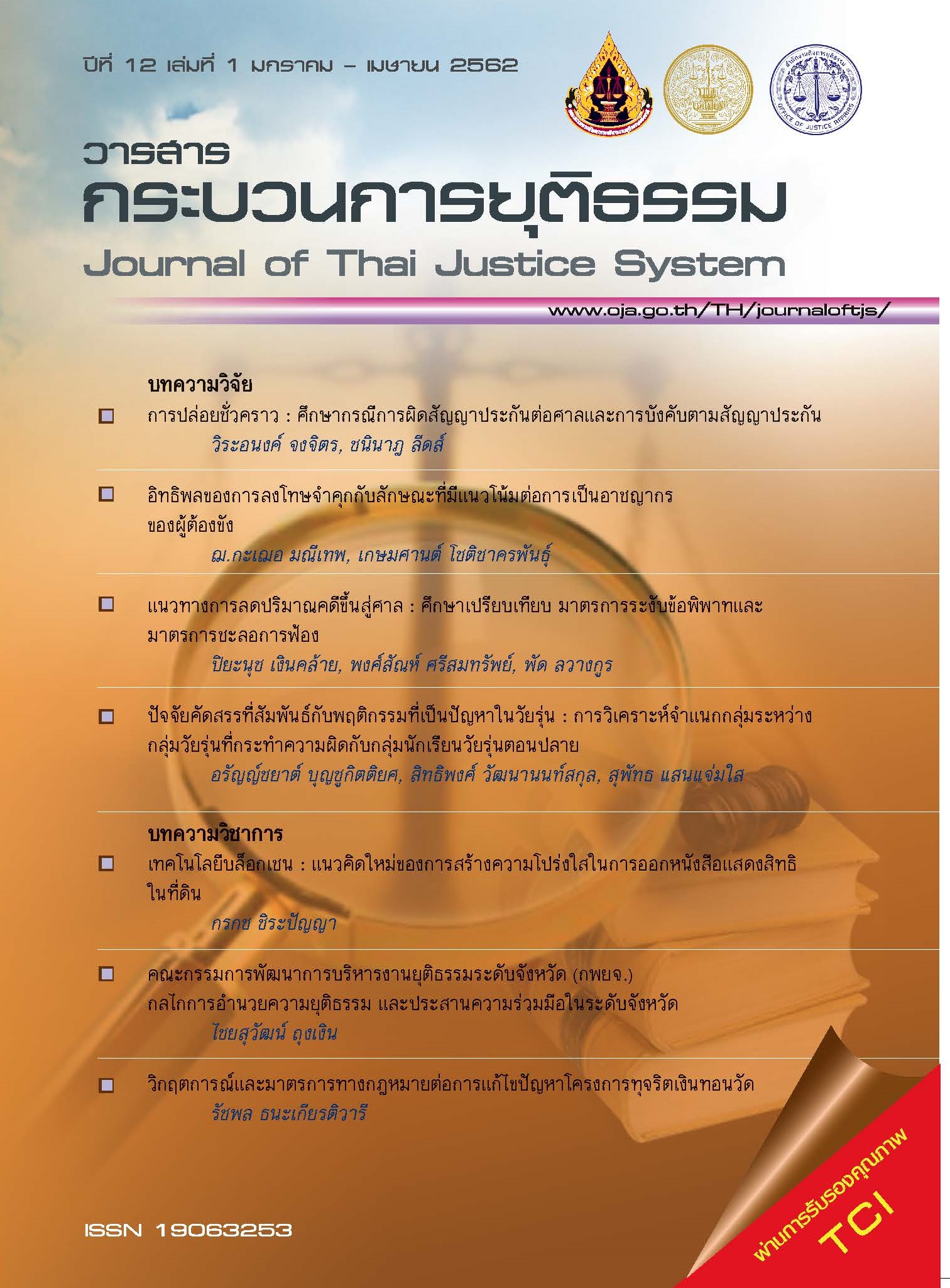แนวทางการลดปริมาณคดีขึ้นสู่ศาล: ศึกษาเปรียบเทียบ มาตรการระงับข้อพิพาทและมาตรการชะลอการฟ้อง
Main Article Content
บทคัดย่อ
การวิจัย เรื่องแนวทางการลดปริมาณคดีขึ้นสู่ศาล: ศึกษาเปรียบเทียบมาตรการระงับข้อพิพาทและมาตรการชะลอการฟ้อง มีวัตถุประสงค์การศึกษา 3 ประการ คือ เพื่อศึกษาแนวทางการลดปริมาณคดีขึ้นสู่ศาลของมาตรการการระงับข้อพิพาทของยุติธรรมชุมชนและมาตรการชะลอการฟ้อง ศึกษาปัญหาอุปสรรคในการนำรูปแบบการลดปริมาณคดีขึ้นสู่ศาลของมาตรการการระงับข้อพิพาทของยุติธรรมชุมชนและมาตรการชะลอการฟ้อง และเสนอแนะแนวทางในการลดปริมาณคดีขึ้นสู่ศาลของมาตรการระงับข้อพิพาทของยุติธรรมชุมชนและมาตรการชะลอการฟ้อง
การวิจัยครั้งนี้เป็นการวิจัยเชิงคุณภาพ โดยศึกษาสองกรณีที่เกี่ยวข้อง ได้แก่มาตรการการระงับข้อพิพาทของยุติธรรมชุมชนและมาตรการเกี่ยวกับการชะลอการฟ้อง เก็บรวบรวมข้อมูลจากเอกสารและสัมภาษณ์ผู้ให้ข้อมูลสำคัญที่มีส่วนเกี่ยวข้อง
ผลการวิจัยพบว่า ทั้งสองมาตรการมีแนวทางและรูปแบบในการดำเนินการเพื่อลดปริมาณคดีขึ้นสู่ศาลแตกต่างกันใน 4 ประเด็นสำคัญ คือ ในแง่กฎหมาย บุคคลที่เกี่ยวข้อง กลไกการดำเนินการระหว่างหน่วยงาน และความชัดเจนของวัตถุประสงค์ของมาตรการ
ในส่วนของกรณีศึกษา เรื่อง มาตรการการระงับข้อพิพาทของยุติธรรมชุมชน พบว่าเป็นกฎหมายที่เกิดขึ้นโดยประชาชนและมีเจ้าหน้าที่รัฐเป็นที่ปรึกษาหรือผู้สนับสนุน เกี่ยวข้องกับผู้นำ ปราชญ์ท้องถิ่น จารีต ภูมิปัญญาท้องถิ่น โครงสร้างความสัมพันธ์ทางสังคมของชุมชนและประชาชน มีกลไกการดำเนินการระหว่างหน่วยงานที่ยืดหยุ่นปรับได้ตามความเหมาะสม และมีวัตถุประสงค์ ของมาตรการที่ชัดเจนว่าเป็นไปเพื่อประโยชน์ของชุมชน
ในส่วนของกรณีศึกษา เรื่อง มาตรการเกี่ยวกับการชะลอการฟ้อง พบว่าเป็นกฎหมายที่เกี่ยวข้องกับเจ้าหน้าที่ของรัฐที่ต้องมีอำนาจตามกฎหมาย ได้แก่ ตำรวจ อัยการ ศาล ราชทัณฑ์คุมประพฤติ และตัวแทนสำนักงานสิทธิมนุษยชน มีกลไกการดำเนินการระหว่างหน่วยงานที่ไม่ยืดหยุ่น และมีวัตถุประสงค์ของมาตรการที่ไม่ชัดเจนว่าเป็นไปเพื่อประโยชน์ของบุคคลผู้กระทำผิดหรือเพื่อประชาชน ปัจจุบันยังไม่ผ่านการพิจารณา
เมื่อวิเคราะห์เปรียบเทียบทั้ง 2 กรณีแล้ว สามารถสรุปได้ว่า แนวทางความสำเร็จของยุติธรรมกระแสทางเลือกนั้น ต้องเน้นให้ชุมชนเข้ามามีส่วนร่วมในการอำนวยความยุติธรรม อีกทั้งต้องมีการวางรูปแบบและกลไกการดำเนินงานให้มีการตรวจสอบและถ่วงดุลอำนาจระหว่างผู้ที่มีส่วนเกี่ยวข้อง รวมถึงควรมีการประยุกต์ใช้แนวคิดเรื่องการเสริมพลังของชุมชน การเยียวยา การให้โอกาสผู้กระทำผิดกลับคืนสู่สังคม และการขจัดความขัดแย้ง ในกระบวนการยุติธรรมให้มากขึ้น เพื่อเป้าหมายในการลดปริมาณคดีขึ้นสู่ศาลได้อย่างมีประสิทธิภาพและประสิทธิผล
Article Details
ต้นฉบับที่ได้รับการตีพิมพ์ในวารสาร เป็นลิขสิทธิ์ของวารสารกระบวนการยุติธรรม แต่ความคิดเห็นที่ปรากฏในเนื้อหาของบทความในวารสารกระบวนการยุติธรรม ถือเป็นความรับผิดชอบของผู้เขียนแต่เพียงผู้เดียว
เอกสารอ้างอิง
กฤษณา อนุชน. (2534). การไต่สวนมูลฟ้องคดีราษฎรเป็นโจทก์. (วิทยานิพนธ์ปริญญามหาบัณฑิต).จุฬาลงกรณ์มหาวิทยาลัย, กรุงเทพฯ.
กิตติพงษ์ กิตติยารักษ์. (2544). ยุทธศาสตร์การปฏิรูปกระบวนการุติธรรมทางอาญาไทย. กรุงเทพฯ:สำนักงานกองทุนสนับสนุนการวิจัย.
กองนโยบายและแผน กระทรวงยุติธรรม. (2544). เอกสารผลการศึกษาแนวทางลดปริมาณคดีขึ้นศาล. กรุงเทพฯ: กองนโยบายและแผน
สำนักงานปลัดกระทรวงยุติธรรม. (2556). คู่มือประกอบการปฏิบัติงานของเครือข่ายยุติธรรมชุมชนเพื่อการเข้าถึงความยุติธรรมของประชาชน. กรุงเทพฯ: ม.ป.พ.
จักรกริญน์ ทอดสูงเนิน และอรนันท์ กลันทปุระ. (2557). "ปัจจัยที่มีผลต่อความสำเร็จของการไกล่เกลี่ยข้อพิพาทในชุมชน กรณีศึกษา ศูนย์ยุติธรรมชุมชนตำบลโคกขาม อำเภอเมือง จังหวัดสมุทรสาคร". วารสารสังคมศาสตร์และมนุษยศาสตร์, 40(1), 98-113.
จุฑารัตน์ เอื้ออำนวย. (2548). กระบวนการยุติธรรมเชิงสมานฉันท์ : การคืนอำนาจแก่เหยื่ออาชญากรรมและชุมชน. กรุงเทพฯ: สำนักงานกองทุนสนับสนุนการวิจัย.
จุฑารัตน์ เอื้ออำนวย. (2551). ยุติธรรมชุมชน : การเปิดพื้นที่ของชุมชนในการอำนวยความยุติธรรม. กรุงเทพฯ: โครงการพัฒนาระบบกฎหมายไทย สำนักงานกองทุนสนับสนุนการวิจัย.
จุฑารัตน์ เอื้ออำนวย. (2556). ระบบยุติธรรมและยุติธรรมทางเลือก แนวการวิเคราะห์เชิงสังคมศาสตร์. กรุงเทพฯ: สำนักพิมพ์แห่งจุฬาลงกรณ์มหาวิทยาลัย.
ณัฐพงศ์ ปัทมโรจน์ และสุวิชา เป้าอารีย์. (2558). ทุนของสังคมในกระบวนการยุติธรรมเชิงสมานฉันท์: กรณีศึกษาศูนย์ยุติธรรมชุมชนพนมสารคาม. Veridian E-Journal, 8(2), 392-407.
เดชา สังขวรรณ และคณะ. (2550). ความยุติธรรมเชิงสมานฉันท์ในระบบงานคุมประพฤติ. กรุงเทพฯ: สำนักงานกองทุนสนับสนุนการวิจัย.
บันลือ คงจันทร์ และปัทมา เผ่าสังข์ทอง. (2544). การระงับข้อพิพาทก่อนขึ้นสู่ศาล. การสัมมนาทางวิชาการเรื่องแนวทางการพัฒนาการยุติข้อพิพาทโดยกระบวนการยุติธรรมทางเลือกในประเทศไทย, กรุงเทพฯ.
บัณฑิต ถึงลาภ. (2547). การชะลอการฟ้องกับการใช้อำนาจตุลาการ. การอบรมหลักสูตรหลักสูตร “ผู้พิพากษาชั้นต้น”. สถาบันพัฒนาข้าราชการศาลยุติธรรม.
ประทีป สุขสนาน และคณะ. (2554). กระบวนการเรียนรู้เพื่อสร้างความเข้มแข็งศูนย์ยุติธรรมชุมชน ตำบลปากแจ่ม อำเภอห้วยยอด จังหวัดตรัง. กรุงเทพฯ: สำนักงานกองทุนสนับสนุนการวิจัย.
พรชัย ขันตี. (2553). ทฤษฎีอาชญาวิทยา: หลักการ งานวิจัย และนโยบายประยุกต์. กรุงเทพฯ: สุเนตร์ฟิล์ม.
รัชกร โชติประดิษฐ์ และชัช วงศ์สิงห์. (2551). ปัญหาการมีส่วนร่วมขององค์กรปกครองส่วนท้องถิ่นในกระบวนการยุติธรรมชุมชน: ศึกษาเฉพาะกรณีองค์กรปกครองส่วนท้องถิ่นในพื้นที่เขตอำเภอวารินชำราบ จังหวัดอุบลราชธานี. กรุงเทพฯ: ฐานข้อมูลโครงสร้างพื้นฐานภาครัฐด้านวิทยาศาสตร์และเทคโนโลยี กระทรวงวิทยาศาสตร์และเทคโนโลยี.
รัฐลักษณ์ พิทักษ์จักรพิภพ. (2555). การเสริมสร้างชุมชนเข้มแข็งเพื่อการป้องกันและแก้ไขปัญหา ยาเสพติด: กรณีศึกษาศูนย์ยุติธรรมชุมชน ตำบลตลิ่งชัย อำเภอจะนะ จังหวัดสงขลา. วารสารกระบวนการยุติธรรม. 5(1). 109-123.
ราตรี ปักษี. (2554). กระบวนการการเรียนรู้เพื่อสร้างความเข้มแข็งศูนย์ยุติธรรมชุมชน ตำบลเกาะสุกร อำเภอปะเหลียน จังหวัดตรัง. กรุงเทพฯ: สำนักงานกองทุนสนับสนุนการวิจัย.
สำนักงานศาลยุติธรรม. (2558). รายงานสถิติคดีศาลยุติธรรมทั่วราชอาณาจักร ประจำปี พ.ศ. 2557 ค้นจาก http://www.oppb.coj.go.th/doc/data/oppb/oppb_1467771254.pdf
สำนักงานศาลยุติธรรม. (2559). รายงานสถิติคดีศาลยุติธรรมทั่วราชอาณาจักร ประจำปี พ.ศ. 2558 ค้นจาก http://www.coj.go.th/home/file/Annual_Tha_2558.pdf
สำนักงานศาลยุติธรรม. (2560). รายงานสถิติคดีศาลยุติธรรมทั่วราชอาณาจักร ประจำปี พ.ศ. 2559 ค้นจาก http://www.oppb.coj.go.th/doc/data/oppb/oppb_1493262382.pdf
สำนักงานปลัดกระทรวงยุติธรรม. (2558). รายงานสรุปผลจำนวนการจัดตั้งศูนย์ยุติธรรมชุมชนและเครือข่ายยุติธรรมชุมชน กระทรวงยุติธรรม. ค้นจากhttps://data.go.th/DatasetDetail.aspx?id=ab5c65aa-59f2-45b6-bd1d-fb01e86372e3
วรพล พินิจ. (2560). บทบาทของสำนักงานยุติธรรมจังหวัดกับการขับเคลื่อนนโยบายสาธารณะเพื่ออำนวยความยุติธรรมในสังคม. วารสารสำนักหอสมุดมหาวิทยาลัยทักษิณ. 6. 41-63.
วิวิสวาจี จิตอารีย์. (2555). ปัจจัยที่ส่งผลต่อการปฏิบัติงานของเครือข่ายยุติธรรมชุมชน จังหวัดกำแพงเพชร. กรุงเทพฯ: มหาวิทยาลัยเกษตรศาสตร์.
ศุภกิจ แย้มประชา. (2543). บทบาทของอัยการในการกันผู้กระทาความผิดออกจากการฟ้องคดีต่อศาล. (วิทยานิพนธ์ปริญญามหาบัณฑิต). มหาวิทยาลัยธรรมศาสตร์, กรุงเทพฯ.
สนอง หนูวงษ์. (2555). กระบวนการเรียนรู้เพื่อสร้างความเข้มแข็งศูนย์ยุติธรรมชุมชนตำบลนาหมื่นศรี อ.นาโยง จ.ตรัง. กรุงเทพฯ: สำนักงานกองทุนสนับสนุนการวิจัย.
สุข บุปผา ,พีรพล สิมมา, และ กาบแก้ว ปัญญาไทย. (ม.ป.ป.). การมีส่วนร่วมในงานยุติธรรมชุมชน จังหวัดตาก. กรุงเทพฯ: วิทยาลัยนอร์ทเทิร์น.
สุทน ศรีสุข และคณะ. (2553). กระบวนการเรียนรู้เพื่อสร้างความเข้มแข็งเครือข่ายยุติธรรมชุมชน (ระดับตำบล) จังหวัดตรัง. กรุงเทพฯ: สำนักงานกองทุนสนับสนุนการวิจัย.
สุภัทรา กรอุไร. (2543). การประนอมข้อพิพาททางอาญา. (วิทยานิพนธ์ปริญญามหาบัณฑิต). มหาวิทยาลัยธรรมศาสตร์, กรุงเทพฯ.
เสกสิทธิ์ สวรรยาธิปัติ. (2554). การกระทำผิดเกี่ยวกับทรัพย์ ยาเสพติด และชีวิตร่างกาย (คดีร้ายแรง) ของเด็กและเยาวชนในเขตกรุงเทพมหานครและปริมณฑล การศึกษาวิจัยโดยใช้ทฤษฎีการควบคุมตนเอง. (วิทยานิพนธ์ปริญญาดุษฎีบัณฑิต). มหาวิทยาลัยมหิดล, นครปฐม.
อุสมาน สารี , อับดุลรอนิง สือแต , อับดุลรอยะ บินเซ็ง , สามารถ ทองเฝือ , ซุกรี หะยีสาแม , กามารุดดีน อิสายะ, ... อับดุลเล๊าะ หมัดอะด้ำ. (2552). การส่งเสริมบทบาทเยาวชนระดับอุดมศึกษาเพื่อพัฒนากระบวนการยุติธรรมชุมชน ในพื้นที่จังหวัดชายแดนภาคใต้. กรุงเทพฯ: นักงานคณะกรรมการวิจัยแห่งชาติ.
หนังสือต่างประเทศ
Coates, Robert B. (2001). Victim Offender Mediation in The United States: A Multisite Assessment. The Handbook of Victim Offender Mediation: An Essential Guild to Practice and Research. San Francisco: JOSSER-BASS.
Dittenhoffer, T., and Ericson, R.V. (1983). The victim offender reconciliation program: A message to correctional reformers. University of Toronto Law Journal, 33(3), 315-347.
Dowling, Brian. (2004). Restorative Intervention Consent Rates. Retrieved from file:///C:/Users/User/Downloads/Guidesheet_PartFunnel.pdf.
Earle, R. (2007). Working Definitions of Community Justice. Retrieved from https://www.nij.gov/topics/courts/restorative-justice/pages/definitions2.aspx.
Hirschi, T. (1969). Cause of Delinquency. Berkley, C.A.: University of California Press.
Johnstone, G. and Daniel Van Ness. (2007). Handbook of Restorative Justice. Willan. Devon. UK: Routledge.
Rehabilitation. Retrieved from http://en.wikipedia.org/wiki/Rehabilitation_(penology).
Restitution. Retrieved from http http://en.wikipedia.org/wiki/Restitution.
Roach, K. (2000). Changing Punishment at the Turn of the Century: Restorative Justice on the Rise. Canadian Journal of Criminology. 42(3). 249 - 280.
Umbreit, M S. (1998). Restorative Justice through Victim-Offender Mediation: A Multi-Site Assessment. Western Criminology Review ,1(1), 1-28. Retrieved from http://wer.sonoma.edu/v1n1/umbreit.html.
Umbreit, Mark S. (2000). Directory of victim offender mediation programs in the US. Center for Restorative Justice & Peacemaking, School of Social Work, University of Minnesota. Saint Paul, Minnesota: University of Minnesota.
Umbreit, Mark S. (2001). The handbook of victim offender mediation: an essential guide to practice and research. Jossey-Bass: San Francisco.
Williams, B. (2005). Victims of Crime and Community Justice. London. Jessica Kingsley.
Wilson, J. and Kelling, G. (March 1982). Broken Windows. Atlantic Monthly, 29-38.
Zehr, H. (1990). Changing Lenses: A New Focus for Crime and Justice. Scottsdale, PA: Herald Press.


